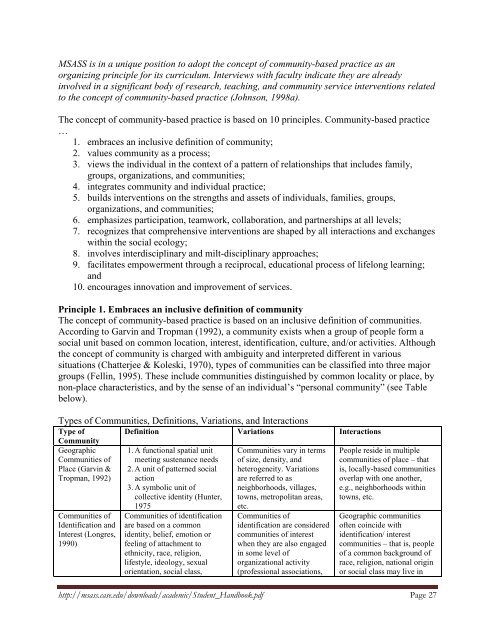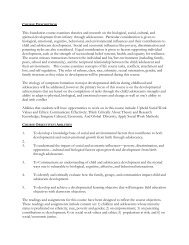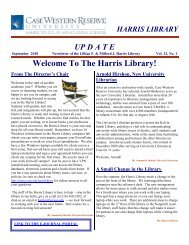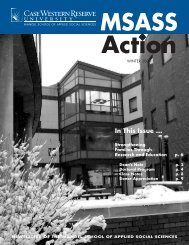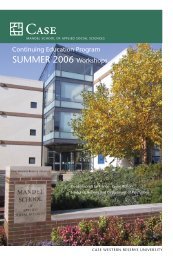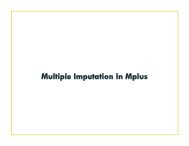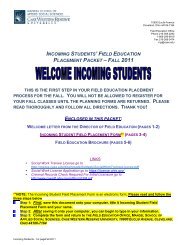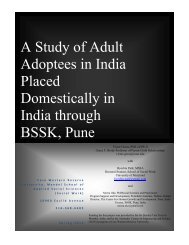MSASS is in a unique position to adopt the concept <strong>of</strong> community-based practice as anorganizing principle for its curriculum. Interviews with faculty indicate they are alreadyinvolved in a significant body <strong>of</strong> research, teaching, and community service interventions relatedto the concept <strong>of</strong> community-based practice (Johnson, 1998a).The concept <strong>of</strong> community-based practice is based on 10 principles. Community-based practice…1. embraces an inclusive definition <strong>of</strong> community;2. values community as a process;3. views the individual in the context <strong>of</strong> a pattern <strong>of</strong> relationships that includes family,groups, organizations, and communities;4. integrates community and individual practice;5. builds interventions on the strengths and assets <strong>of</strong> individuals, families, groups,organizations, and communities;6. emphasizes participation, teamwork, collaboration, and partnerships at all levels;7. recognizes that comprehensive interventions are shaped by all interactions and exchangeswithin the social ecology;8. involves interdisciplinary and milt-disciplinary approaches;9. facilitates empowerment through a reciprocal, educational process <strong>of</strong> lifelong learning;and10. encourages innovation and improvement <strong>of</strong> services.Principle 1. Embraces an inclusive definition <strong>of</strong> communityThe concept <strong>of</strong> community-based practice is based on an inclusive definition <strong>of</strong> communities.According to Garvin and Tropman (1992), a community exists when a group <strong>of</strong> people form asocial unit based on common location, interest, identification, culture, and/or activities. Althoughthe concept <strong>of</strong> community is charged with ambiguity and interpreted different in varioussituations (Chatterjee & Koleski, 1970), types <strong>of</strong> communities can be classified into three majorgroups (Fellin, 1995). These include communities distinguished by common locality or place, bynon-place characteristics, and by the sense <strong>of</strong> an individual’s “personal community” (see Tablebelow).Types <strong>of</strong> Communities, Definitions, Variations, and InteractionsType <strong>of</strong>CommunityGeographicCommunities <strong>of</strong>Place (Garvin &Tropman, 1992)Communities <strong>of</strong>Identification andInterest (Longres,1990)Definition Variations Interactions1. A functional spatial unitmeeting sustenance needs2. A unit <strong>of</strong> patterned socialaction3. A symbolic unit <strong>of</strong>collective identity (Hunter,1975Communities <strong>of</strong> identificationare based on a commonidentity, belief, emotion orfeeling <strong>of</strong> attachment toethnicity, race, religion,lifestyle, ideology, sexualorientation, social class,Communities vary in terms<strong>of</strong> size, density, andheterogeneity. Variationsare referred to asneighborhoods, villages,towns, metropolitan areas,etc.Communities <strong>of</strong>identification are consideredcommunities <strong>of</strong> interestwhen they are also engagedin some level <strong>of</strong>organizational activity(pr<strong>of</strong>essional associations,People reside in multiplecommunities <strong>of</strong> place – thatis, locally-based communitiesoverlap with one another,e.g., neighborhoods withintowns, etc.Geographic communities<strong>of</strong>ten coincide withidentification/ interestcommunities – that is, people<strong>of</strong> a common background <strong>of</strong>race, religion, national originor social class may live inhttp://msass.case.edu/downloads/academic/<strong>Student</strong>_<strong>Handbook</strong>.pdf Page 27
PersonalCommunity(Davidson, 1986)pr<strong>of</strong>ession, type <strong>of</strong>employment, etc. (AfricanAmerican community, theCatholic community, the gaycommunity, etc.)This concept <strong>of</strong> communityfocuses on the membership <strong>of</strong>an individual in multiplecommunitiesreligious groups, and ethnicorganizations)Personal communitiesconsist <strong>of</strong> all communities –geographic, identificational,and interest – in which oneengages in socialinteraction, in use <strong>of</strong>services and resources,employment, and leisureactivitiesresidential areas with a highproportion <strong>of</strong> people with thesame characteristics.This definition <strong>of</strong> communitybroadens the scope <strong>of</strong>potential social interactionsand resources, including bothformal and informal helpingnetworks. The personalcommunity is a context forinterpersonal treatment andintervention goals, as well asgoals that seek to changeorganizations andcommunitiesPrinciple 2. Values community as a process• Communities change over time• There are differences within communities and between communities• Communities can be nurturing environments that positively influence the ability <strong>of</strong> theindividual, family group, and organization to develop healthily in unfriendly places thatnegatively contribute to a locus <strong>of</strong> problem perpetuating patterns• The worker becomes a part <strong>of</strong> the community through formal and informal relationshipsthat involve networking, information sharing, and other activities• Building community takes time, commitment, and expertise• A key social work function involves participating in and building communities thatincrease resilience at the individual, family, group, and organizational levelsPrinciple 3. Views the individual in the context <strong>of</strong> a pattern <strong>of</strong> relationships that includesfamily, groups, organizations, and communities• Practice with individuals involves formal and informal relationships in the community• Family members, kin, neighbors and other social networks and social supports are centralto developing and managing interactions and exchanges• The social ecology includes ethnic/racial, cultural, social class, economic, and politicalenvironments• Assessment and mutual process carried out “with” a client/client system and includescareful consideration <strong>of</strong> all levels <strong>of</strong> analysis – that is, family, group, organizations, andcommunitiesPrinciple 4. Integrates community and individual practice• Community-based practice is a perspective that integrates the traditional “either/or”approaches <strong>of</strong> micro and macro practice into a “both/and” approach• Community-based practice recognizes that teamwork among practitioners with differingareas <strong>of</strong> expertise may be needed to effect meaningful and enduring change• Community-based practice involves a range <strong>of</strong> different intervention modalities designedto bring about hope that meaningful change can occurhttp://msass.case.edu/downloads/academic/<strong>Student</strong>_<strong>Handbook</strong>.pdf Page 28
- Page 1 and 2: MSSAStudentand FacultyManual2012-20
- Page 3 and 4: TABLE OF CONTENTSWELCOME TO MSASS!
- Page 5 and 6: From the University ...............
- Page 7 and 8: CASE AND MSASS OVERVIEWCase Western
- Page 9 and 10: Convenient Facilities:Degree Progra
- Page 11 and 12: 2. Advocate for Social, Economic, a
- Page 13 and 14: Advanced LevelKnowledge:• Underst
- Page 15 and 16: Foundation LevelKnowledge:• Criti
- Page 17 and 18: Assessment:‣ Can ask relevant que
- Page 19 and 20: • Knows the requirements of infor
- Page 21 and 22: • Develops skills in engaging per
- Page 23 and 24: • Evaluates own practice effectiv
- Page 25 and 26: • Deals effectively with change i
- Page 27: Involving service users and other c
- Page 31 and 32: • Community-based practice social
- Page 33 and 34: Jarman-Rohde, L., McFall, J., Kolar
- Page 35 and 36: social workers are required to coop
- Page 37 and 38: Community and Social Development at
- Page 39 and 40: • Assessment issues, skills and t
- Page 41 and 42: PROGRAMS AND OPTIONS FOR STUDYTwo-Y
- Page 43 and 44: The Part-Time Program may be comple
- Page 45 and 46: For additional information, please
- Page 47 and 48: Mandel School of Applied Social Sci
- Page 49 and 50: For more information, visit the pro
- Page 51 and 52: miss more than one day; in the full
- Page 53 and 54: Friday (6 class contact hours)Morni
- Page 55 and 56: Emotional/Health/Medical Problems
- Page 57 and 58: The associate dean for academic aff
- Page 59 and 60: c) The academic team member may con
- Page 61 and 62: VII. Appeal1) The student may appea
- Page 63 and 64: writing, to the Associate Dean for
- Page 65 and 66: • Treating the person in a prefer
- Page 67 and 68: Testing dates are noted on the acad
- Page 69 and 70: SOCIAL WORK LICENSINGWhen MSASS stu
- Page 71 and 72: MSASS TUITIONNew students accepted
- Page 73 and 74: For additional information about th
- Page 75 and 76: Case Western Reserve University has
- Page 77 and 78: Escort ServiceCase student escort s
- Page 79 and 80:
is disclosure to school officials w
- Page 81 and 82:
Data on retention and graduation ra
- Page 83 and 84:
The college years mark a time when
- Page 85 and 86:
Guidelines for Reserves1. Requests
- Page 87 and 88:
• Option to time release of quizz
- Page 89 and 90:
Computer LabThe MSASS Computer Lab
- Page 91 and 92:
Students must be in good academic s
- Page 93 and 94:
the form (it would be helpful to ke
- Page 95 and 96:
UNIVERSITY POLICIESALCOHOL USE AND
- Page 97 and 98:
There are certain circumstances whe
- Page 99 and 100:
• incest• sexual assault with a
- Page 101 and 102:
FINDING YOUR WAY…Academic Calenda
- Page 103 and 104:
OFFICES OF ACADEMIC AFFAIRS, STUDEN
- Page 105 and 106:
MANDEL SCHOOL ADMINISTRATIONGrover
- Page 107 and 108:
CURRICULUM “GO TO” PEOPLECONCEN
- Page 109 and 110:
http://msass.case.edu/downloads/aca
- Page 111 and 112:
Claudia J. Coulton, PhD(Case Wester
- Page 113 and 114:
Eva Kahana, PhD(University of Chica
- Page 115 and 116:
Diana Morris, PhD(Case Western Rese
- Page 117 and 118:
Zoe Breen Wood, MSW(Virginia Common
- Page 119 and 120:
College Station (216-791-1600) T-W:
- Page 121 and 122:
Marc’s Coventry (216-320-1000) M-
- Page 123 and 124:
Radisson Hotel at Gateway - Downtow


